7: Brands and Packs
The introduction of brands commenced during the late 19th century as a development of the old qualities: Moguls, Harrys, Highlanders and Merry Andrews.
 Some collectors like to collect the different brands produced by various makers. One aspect of this which may be overlooked is that a brand will not always have the same cards in the box, or different brands will often have the same cards. This has been the case since the introduction of brands during the late 19th century as a development of the old qualities: Moguls, Harrys, Highlanders and Merry Andrews. Those brands that have been on offer for many years, e.g. USPCC Bicycle cards, have a varied array of ASs and court types. So it is important to specify the make-up of a pack as separate from the brand name. This is one disadvantage of the Hochman classification system. It is actually a classification of ASs (and jokers, where appropriate), not of brands, and it is sometimes difficult to know what the court cards are like in any particular instance. For example, if we take NY37, which is illustrated in full on page 13, we find different courts with the same AS.
Some collectors like to collect the different brands produced by various makers. One aspect of this which may be overlooked is that a brand will not always have the same cards in the box, or different brands will often have the same cards. This has been the case since the introduction of brands during the late 19th century as a development of the old qualities: Moguls, Harrys, Highlanders and Merry Andrews. Those brands that have been on offer for many years, e.g. USPCC Bicycle cards, have a varied array of ASs and court types. So it is important to specify the make-up of a pack as separate from the brand name. This is one disadvantage of the Hochman classification system. It is actually a classification of ASs (and jokers, where appropriate), not of brands, and it is sometimes difficult to know what the court cards are like in any particular instance. For example, if we take NY37, which is illustrated in full on page 13, we find different courts with the same AS.
 [From the plainbacks website.]
[From the plainbacks website.]
Similarly with many English brands, it is possible to trace differently constituted packs. The best way to deal with this variation is to spell out in each case the AS and courts (and, for those who wish, the joker(s)). This information, sometimes along with the style of the box, will give a reasonable indication of the date. The card-makers themselves had a variety of brands, but they also made cards for other firms, in particular wholesale stationers and large stores, such as Harrod's, Selfridge's, Lewis's (of Manchester, Liverpool and Leeds), Boots, W.H. Smith's and L.G. Sloan. Sometimes a firm will change the provider of their cards, so that the contents can alter drastically. The Délési (later without the acute accents) brand for W.H. Smith & Son started with the bridge-width Goodall G7 courts before World War I and then the cards changed to the De La Rue version of the whist cards after their take-over of Goodall, GD10 in the 1920s and 30s, then GDW12 until the litho courts GDW13 took over c.1980. But in the early 1990s Smith's changed to the USPCC as their supplier with US5 courts (originally designed by the American Banknote Co). Nowadays their cards are provided by Carta Mundi and the old brand name has been dropped.
Here are a few examples of English brands with a brief comment on their history (if I know it). Neil Darbyshire (of the EPCS) has a lot more information on brands and has published a number of articles in the society's Newsletter.
(1) Délési for W H Smith. This brand goes back to at least 1910 and has always been bridge-width. The illustrated examples are later. The red and blue ones with the same back design are from some time around World War II with interesting boxes: the top one has a slide-in, fold-over inner cardboard envelope (like some card games) and the lower one has a slip-in box. Because of wartime shortages old stock and cheap variants of boxes were often used. The bottom example is by USPCC from 1993 after W H Smith had changed their supplier from Waddington.

(2) Another Goodall/De La Rue brand for one particular outlet was Rufford for Boots the Chemist. Neil Darbyshire has recently written up this brand in the EPCS Newsletter. It appears to have been started about 1930 and continued until the early 1960s. The top two examples are from c.1930-35. Note that the anonymous AS6.1 (formerly Goodall's London Playing Card Co design) has been used in the middle one. The bottom one is from c.1955 with a redesigned AS.

(3) An earlier brand for Boots by Goodall from c.1910 in both wide and bridge width was Damask, as illustrated below (wide).

The middle row is another long-lasting Goodall/De La Rue brand, Prize Medal, dating back to c.1880 and continuing until WWII. I think they were always wide cards. The illustrated example is by De La Rue from c.1925 (note the index and court type and EC1 on the box).
The bottom row illustrates two Waddington packs. On the right is an example of the cards available under the Wills cigarette scheme of 1933-34. Since three to four million packs were produced for this scheme, it may be that left-over stock was put on the open market. The ASs were always anonymous.
The left and centre examples are from c.1975. Linette was another of the Goodall pre-WWI brands. Originally it appeared as Linette 1909 with wide cards, usually of type G8, and narrow cards with G7 courts. These continued until c.1925 under De La Rue. Linette also appears with GD10 courts from c.1922 onwards. Eventually it became a bridge-width brand. The Waddington version above is the last one before it disappeared.
(4) Another well established brand was New Bond by Universal (Alf Cooke) for F W Woolworth. This ran from c.1938 until c.1972. Another Woolworth brand was De Luxe, which was more expensive than New Bond. De Luxe is one of the early Universal brands going back to c.1927, but there is no reference to Woolworth on the boxes of these early versions. Top: for Woolworth, & Co AS, c.1955; bottom two, unmarked, Ltd ASs, c.1930.

(5) More by Universal. Top: 4 indices, Cooke AS, c.1960. Middle: 2 indices, & Co AS, one joker (i.e. before canasta), c.1948. Bottom: for L G Sloan, stationers, with special AS and joker, c.1935 [not for Woolworth]

(6) As an example of a smaller firm selling their own brand, here's a pack of Deansgate playing cards by De La Rue for John Heywood Ltd, Deansgate, Manchester. They are very ordinary cards with the ubiquitous anonymous Goodall/London PC AS and the back used in De La Rue's own Crown brand. Without the box, they would be impossible to identify. They date from c.1937.

The firm was a wholesale stationers with a retail outlet (which I used to visit in search of cards as a boy!) in the shopping street, Deansgate. Their price list is the source for the 1897/98 brands given below. The original is in the John Johnson Collection at the Bodleian Library, Oxford.

Front cover
(7) I have a few old price lists for a number of makers and it is interesting to see what brand-names, if any, were used. Willis, for example, used only the back designs to distinguish packs to start with, but later introduced the traditional names; Joseph Hunt & Sons (the later firm) were the same. James English used the traditional grades: Moguls, Harrys and Highlanders. De La Rue also used the traditional names of the grades, including Andrews, the cheapest grade, but from c.1885 added to these. But it was Goodall who took brand-names to considerable lengths, and it's not at all clear to me why, though they may have used subtle differences in the colour range of the back designs, quality of the card itself and other production features to differentiate the various brands. I thought it might be interesting to give a list of De La Rue's and Goodall's brands at different times to show how some were retained for many years, whereas others came and went.
About 1885; many of these have round corners and indices:
- Palace Gold Dexter Moguls
[Dexter refers to the index within the pip] - Palace Dexter Moguls
- Extra-figured Moguls
- Gold Moguls
- Figured Moguls
- "Slider" Moguls
- Club-house Moguls
- Victoria Moguls
[French size; not sure what they were like by this date] - Gold/Figured/Enamelled Harrys
- Second/Third Moguls & Harrys
- Travellers' [patience cards]
- Enamelled/Coloured Highlanders
- Andrews
- Pantaloons
- Harlequins
- Andrews
- Highlanders
- Club Harrys
- Rajahs
- Chancellors
- Viceroys
- Premiers
- Statesmen
- Consuls
- Sultans
- Harrys
- Ambassadors
- Presidents
- Columbines
- Moguls [including Shakespere (sic)]
1897-98
- Pneumatic
- Palace/Figured Dexter Moguls
- Gold/Slider/Figured Moguls
- Club-house Moguls/Harrys
- Gold/Figured/Enamelled Harrys
- Mandarins
- Swifts
- Second Moguls/Third Harrys
- Enamelled Highlanders
- Racers
- Andrews
- Patience
- Pigmy/Midget [toy size]
- Pantaloons
- Pashas
- Club Harrys
- Viceroys
- Caliphs
- Rajahs
- Premiers
- Gem/Ruby Gem
- Star
- Japanese Lacquer
- Sultans
- Statesmen
- Harrys
- Oceanics
- Khedives
- Moguls No. 836 & 254
- Atlantics
- Mikados
- British Americans
- Pioneer Moguls
- Moguls [including Shakespeare, Thick]
- Acme
1931 (both firms together):
- Pneumatic [narrow & wide]
- Boudoir*
- Palace*
- Initial*
- Swifts*
- Clan Tartan
- Popular*
- Historic [non-standard]
- Crown*
- Rameses [fortune-telling]
- Racers
- Linette [narrow & wide]
- Arpak
- Imperial Club
- No.1 Pigmy [toy size]
- Colonials No. 42 & 24
- Cruisers
- Anchor*
- Pashas
- Elfin [toy size]
- Tom Thumb [toy size]
*Narrow size
The details of some of these brands are not always clear, but, for instance, the 1897/98 Shakespeare back will have square corners and no indices. It's interesting to see how long some of the brands lasted, and both the Historic and Rameses packs were available as late as 1931. It makes dating individual packs quite tricky! 1897 sounds better than 1931!! One Goodall brand, in particular, is missing from the 1931 list, though it survived until WWII: Prize Medal, illustrated above. Some brands were reintroduced after the War, for example, Viceroys, though these were boxed as De La Rue and were narrow.
Mike Goodall illustrates a number of Goodall branded boxes in his book on the firm (see page 12 of this blog). He also gives more lists in his booklets on the other card-makers of the period.
As an example of how I would suggest describing individual packs with the same brand-name, I'll take Linette. The order of characteristics could be as follows: maker; courts; AS; (joker); box; (back design); approximate date; other comments. Although I haven't done this in my book on standard English cards, jokers can be given identification numbers (or letters) just like courts, and the same applies to boxes. For example, leaving aside the jokers Goodall made for American packs sold through Mauger, the first joker can be 1, the second, the one that became the standard joker for their packs, 2. Variation in 2 can be designated by decimal points, e.g. 2.1 with ivy at the bottom, 2.2 with ivy and stars in the corners, 2.3 no ivy, but stars, 2.4 as 2.3 but THE JOKER written underneath, and so on. So, now we can see the differences quite clearly (if that is what interests us). N = no joker, and I haven't bothered with the back design.
Sample descriptions: LINETTE
Goodall/De La Rue: G8; 4.4; 2.4; 1909 linen-grained; c.1925 (made by De La Rue) WIDE
Goodall: GD10; 4.2; N; Linette NW; c.1920 (made just before the take-over??) NARROW
Goodall/De La Rue: G6; 4.4; N; Linette NW; c.1925 (made by De La Rue or old stock) WIDE
Goodall/De La Rue: GD10; 4.4; 2.5 (JOKER in corner not star); Linette slip-in, EC1; c.1925.(made by De La Rue) NARROW
Goodall/De La Rue: GD9; 4.4; N; Linette EC1; c.1925 (made by De La Rue) WIDE; damaged. Q-index on QH; for the Worshipful Company of Grocers.
Waddington: GDW12; 3.2; Waddington; Waddington Linette; c.1975; illustrated above
(8) Here are some detailed notes on the De La Rue Crown brand.

Crown brand packs were introduced in c.1930 as bridge cards. The original box design is similar to that of Goodall's wide-size Imperial Club, so it may have been intended as the bridge version.

The pre-war Crown packs had GD10 courts up until c.1933, then GD11 and finally GD12 courts. These seem to have been continued into the war period, as I have a pack in a wartime quality box of the second design above, but with GD12 courts. After the destruction of De La Rue's factory, after the available stock had been sold off, Waddington started to print the Crown brand with the same kind of box, but with their own W5.1 courts. These lasted until the end of the war. In 1946 the card-selling part of the firm became known as De La Rue & Co Ltd, Stationers Division, and this appears on the sides of the box. By this time the courts are W5.4. By 1950 the courts have been replaced by W5.5.
 Crown with Waddington courts: W5.1; W5.4 (crossed hair); W5.5 (no crossed hair)
Crown with Waddington courts: W5.1; W5.4 (crossed hair); W5.5 (no crossed hair)
From the mid-1950s the courts reverted to GDW12 (Waddington printing), and by c.1960 the box had been redesigned as the right-hand example above. In c.1965 until the end of De La Rue's involvement in cards, the box was as below. Although in 1958 the firm was renamed "The De La Rue Company Limited", the card boxes usually had the old name on, as below.

The final version of Crown had Waddington's own name on the box in the early 1970s, after which time the brand disappeared.

So it's possible to be fairly accurate when dating the different versions of this particular brand.
(9) Perhaps the best-known British brand is Waddington's No.1, as it's still being produced. It was first introduced in c.1941 as a cheap brand, taking over from pre-war Viking and Excel, though the latter was reintroduced in the late 1950s. Below are a number of boxes showing differences through time; the contents also hold clues as to dating.

1. First version, W5.1 courts, c.1941-45; 2. Post-war version with rationing restrictions still in force, W5.4 & W5.5 courts, 1946-51; 3. Version after the abolition of the tax, note the apostrophe still in Waddington's, W5.6 courts, 1962-c.1968; 4. Later version after Waddington bought out De La Rue, Goodall courts (GDW12), leek on redrawn AS, 1974-89; 5. Version from just before Hasbro bought out Waddington's games, litho courts (GDW13), Castle Gate, Leeds address on base of box, no 'Leeds' on AS, 1992-95: the same box was used with narrower GDW13.1 courts and a Gwent address on the base, 1995-98; 6. A more recent version, printed in Austria (presumably by Piatnik), 2019. It isn't always easy to know who printed the cards. Winning Moves took over in 1997 and their name appears on the base of the boxes from then on. The two bottom examples are the side of the box where the finger grip is: 7. No reference to country of printing on the base, 2016; 8. The most recent version, made in China, 2022. The Gold version was also printed in China in 2019.

By Ken Lodge
Member since May 14, 2012
I'm Ken Lodge and have been collecting playing cards since I was about eighteen months old (1945). I am also a trained academic, so I can observe and analyze reasonably well. I've applied these analytical techniques over a long period of time to the study of playing cards and have managed to assemble a large amount of information about them, especially those of the standard English pattern. About Ken Lodge →
Trending Articles
Popular articles from the past 28 days
Related Articles
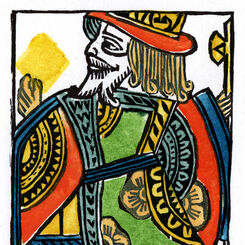
Woodblock and Stencil King of Diamonds
A limited edition art print of the King of Diamonds 1984 woodblock joker.
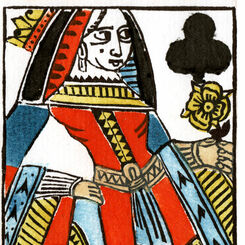
Woodblock and Stencil Queen of Clubs
A limited edition art print of the Queen of Clubs 1984 woodblock joker.
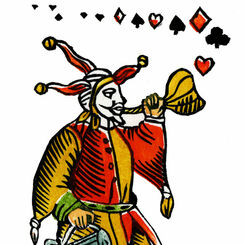
Woodblock and Stencil Joker
A limited edition art print of the 1984 woodblock joker.
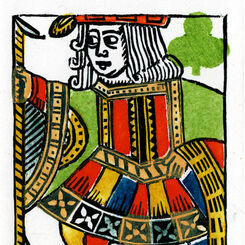
Woodblock and Stencil Jack of Clubs
A limited edition art print of the Jack of Clubs 1984 woodblock joker.
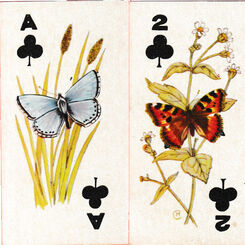
Sweetule Natural History cards
Small cards featuring natural history subjects, given away with packets of sweet cigarettes.
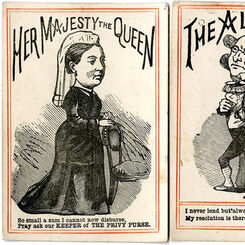
Lend Me Five Shillings
or “Her Majesty’s Privy Purse” - a merry round-the-table game published by D. Ogilvy.
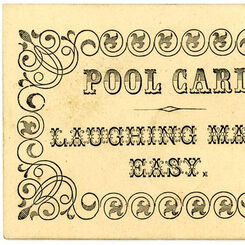
Laughing Made Easy
a Victorian card game published by D. Ogilvy.
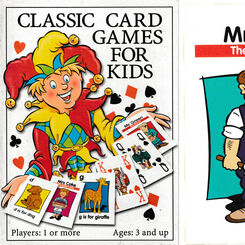
Classic Card Games for Kids
A boxed set of playing cards, Happy Families and an alphabet pack with rules for 22 games.
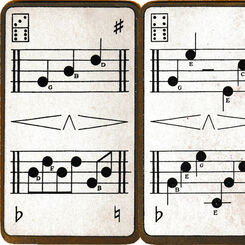
So-Lah – A Game of Music
An early 20th century domino-type musical card game by Goodall.
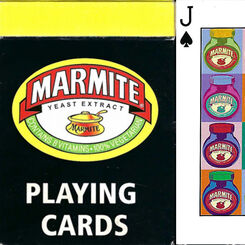
Marmite
Fifty-Four images celebrating a UK savoury spread, that has been around one hundred and twenty two y...
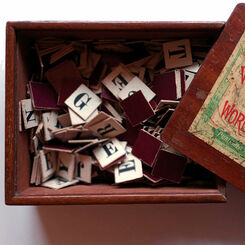
Word Making and Word Taking
How crossword and spelling games became popular.
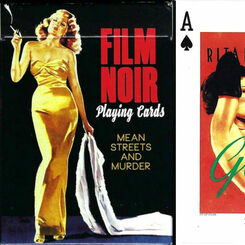
Film Noir
A deck of 55 cards, celebrating hard boiled heroes, wise-cracking women, mean streets, guns and gums...
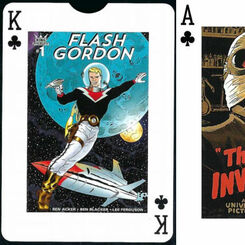
Science Fiction
A deck of 55 cards, celebrating a time when Science Fiction truly was, Science Fiction.
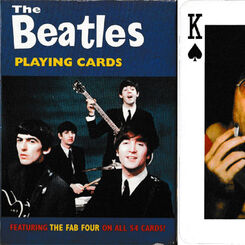
The Beatles playing cards
Two packs featuring photos of The Beatles issued by the same publisher in 2004 and 2005.
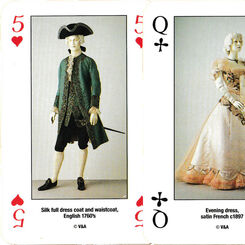
Costume Playing Cards
Four centuries of costumes from the Costume Court at the Victoria and Albert Museum.
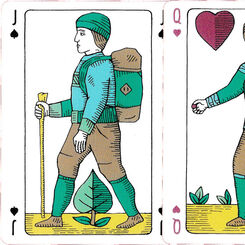
Commoners playing cards
Created by Ian Cumpstey dedicated to the common land and the countryside.
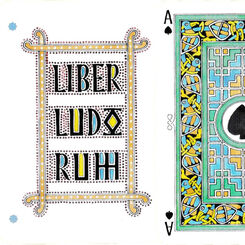
Liber Ludorum
Liber Ludorum playing cards created by Ian Cumpstey in the insular style, United Kingdom, 2019.
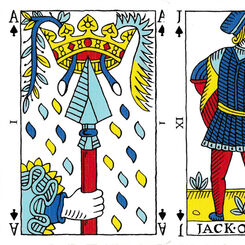
Pike and Clover playing cards
Pike and Clover playing cards created by Ian Cumpstey, Cumbria, UK, 2018.
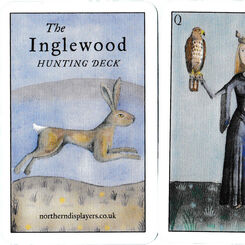
Inglewood Hunting Deck
Inglewood Hunting Deck created by Ian Cumpstey, United Kingdom, 2023.
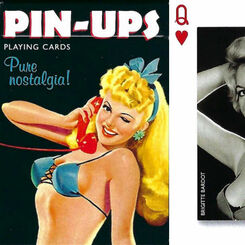
Pin-Ups
A deck of 55 cards celebrating a golden age of cheeky, naughty, bold and curvy ladies in film.
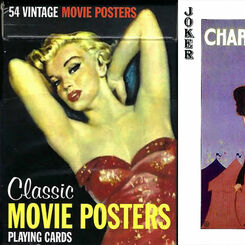
Classic Movie Posters
A deck of 55 cards presenting vintage classic movies and their stars.
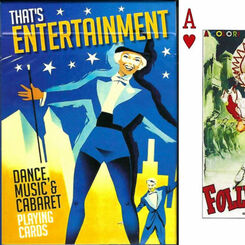
That’s Entertainment
A deck of 55 cards celebrating 20th Century vaudeville, musicals and cabaret.
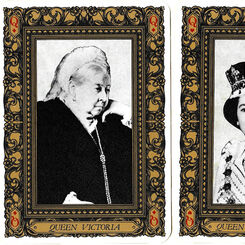
British Monarchs
Commemorating the royal wedding of Charles, Prince of Wales to Lady Diana Spencer on the 29th
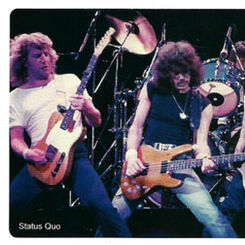
Rock & Pop Legends
Stunning photos of a selection of US and UK music artists.
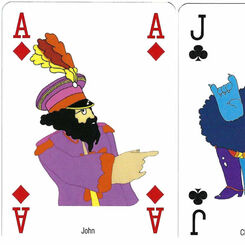
The Beatles • Yellow Submarine
A colourful deck celebrating the 1968 animated feature film based on the Lennon/McCartney song of th...
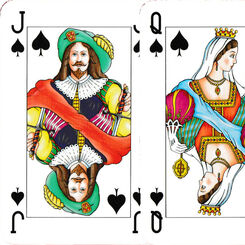
Dutch Court playing cards
Games & Print Services’ version of the Dutch pattern.
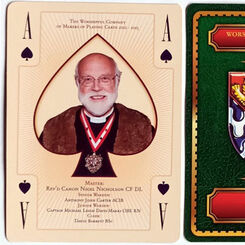
Past Masters’ Association Presentation Pack
The Worshipful Company of Makers of Playing Cards Past Masters’ Association Presentation Pack, 2013....
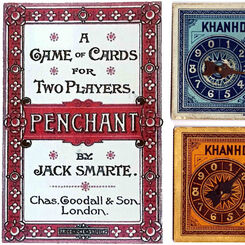
The Search for New Games in the late 19th century
A few new games survived and are still around today; most came and went and are only witnessed in th...
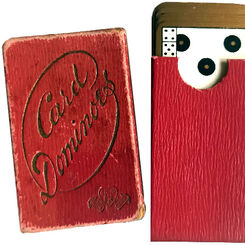
Miniature Card Dominoes
A miniature set of Goodall domino cards (5.9 x 3.5 cms) still in perfect condition.
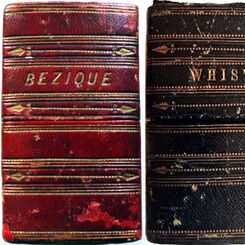
T. Drayton & Son
Bezique and Whist boxed sets by T. Drayton & Son, London, c.1875.
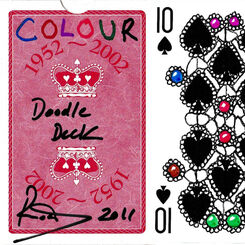
Colour doodle deck
“1952-2002 commemorative deck” customised with doodles by an uncredited artist, UK, 2011.
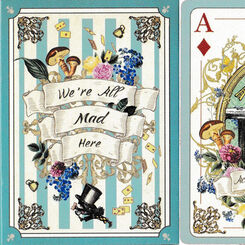
Alice in Wonderland: we’re all mad here
Alice in Wonderland themed playing cards, UK, 2020.
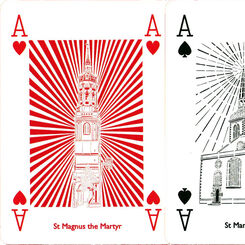
Wren 300 playing cards
Papercuts by Chloe Campbell of the 52 Wren churches in the City of London.
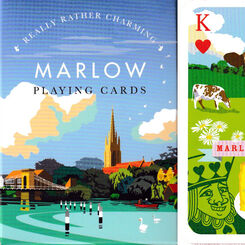
Marlow playing cards
Visitor attractions and businesses to be found in Marlow, Buckinghamshire.
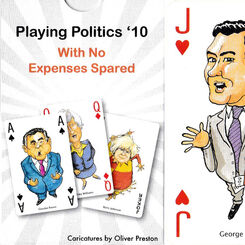
Playing Politics 2010
“Playing Politics ’10: With no expenses spared” featuring caricatures by Oliver Preston, published b...
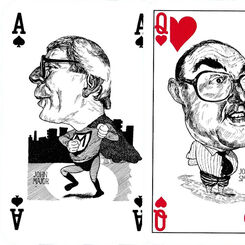
Playing Politics ’92: Pack of lies
Playing Politics ’92: Pack of lies with caricatures by Grant Robertson, UK.
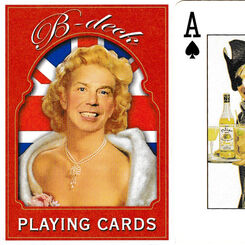
B-Deck
“B-Deck” scurrilous playing cards poking fun at a former UK prime minister.
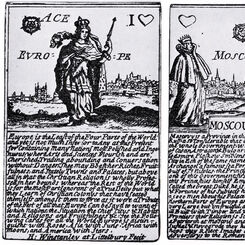
Winstanley Geographical cards
Facsimile of Winstanley’s Geographical cards produced by Harold & Virginia Wayland, 1967.
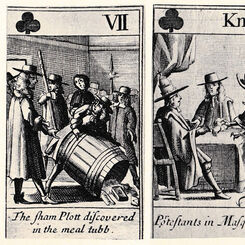
Meal Tub Plot
Meal Tub Plot playing cards [facsimile] with 17th century sketches by Francis Barlow.
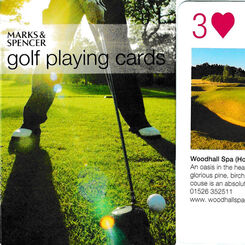
Golf playing cards
Golf playing cards published by Marks & Spencer, UK.
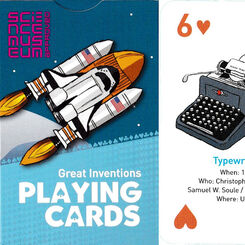
Great inventions playing cards
Great inventions playing cards designed by Gary Wyatt, United Kingdom, 2011.
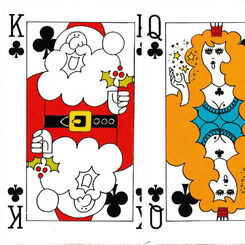
Christmas 1980 playing cards
Festive courts on a Waddingtons pack designed to celebrate Christmas 1980.
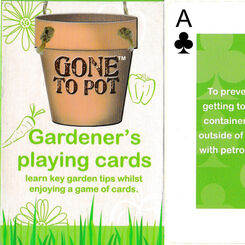
Gone to Pot: Gardener’s playing cards
‘Gone to Pot’: special playing cards for keen gardeners, United Kingdom.
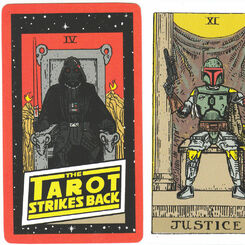
The Tarot Strikes Back
Roy Huteson Stewart's The Tarot Strikes Back combines Star Wars with Rider-Waite tarot imagery.


